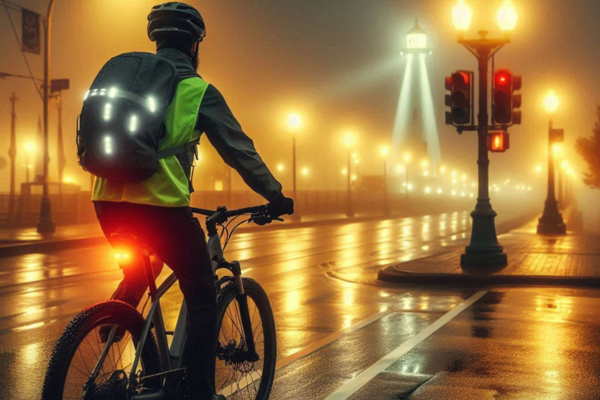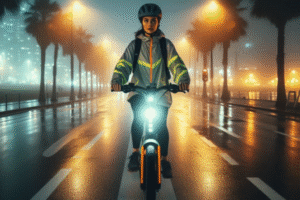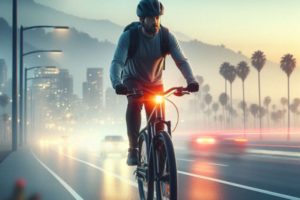🌊 Night Riding in Coastal Cities: The Real Visibility Challenge
Night riding safety for e-bike commuters is not optional—it’s essential. Especially in coastal cities, where fog, sea breeze and low visibility create unique risks. Riding with the right habits and gear transforms every trip into a confident and safe journey.
But under this charm lies a real risk: coastal conditions at night are uniquely dangerous for visibility. Unlike inland cities where streetlights may suffice, coastal towns often face fog, salty mist, wet surfaces, and dim infrastructure, creating a perfect storm for poor night visibility.In places like Santa Monica, Cartagena, and Marseille, these challenges aren’t occasional—they’re a routine part of evening commutes. When sunlight fades, your survival depends on how well others can see you. That’s not dramatic—it’s data-backed. A study by the Insurance Institute for Highway Safety (IIHS) notes that over 50% of fatal bicycle accidents occur during low-light or night conditions, many of them in weather-affected environments.
🌫️ Why Coastal Cities Are Riskier After Dark
Coastal humidity acts like a lens over your lights and reflectors. Here’s how it affects visibility on night rides:
- Salty air corrodes electrical components: Over time, your lighting system may dim or fail entirely.
- Fog diffuses light beams: Making high-lumen lights appear weaker or scattered.
- Reflected glare from wet roads: Headlights bounce unpredictably, hiding cyclists from drivers’ view.
- Frequent power outages in coastal areas: Some beachside cities suffer from unstable grid lighting at night.
In short: even if your e-bike meets daytime visibility standards, it may fall short the moment night and coastal moisture mix. That’s why this article exists—to help you prepare, adapt, and ride smart.
🚴♀️ Who This Guide Is For
This guide is designed for coastal e-bike commuters: students, workers, freelancers, or anyone who depends on their e-bike as a daily tool—not just a hobby. It’s also for riders who:
- Regularly commute near the sea or through wet, foggy neighborhoods
- Travel during early mornings or after sunset
- Have experienced close calls or near-invisible moments on the road
Even if you’ve never had an accident, this guide can help you avoid becoming a statistic. Visibility is not just about legality—it’s about dignity and survival.
🧠 Case Snapshot: Luis in Valparaíso
Luis, a baker in Valparaíso, used to leave work at 5 a.m., just before sunrise. He wore a black hoodie, used only a front light, and had no side reflectors. One morning, he was sideswiped by a delivery van in thick morning fog. Since then, he rides with a 700-lumen headlight, a reflective vest, spoke reflectors, and a tail light strapped to his backpack. “People stop assuming I’m just a shadow now,” he says. “They actually slow down.”
💡 Key Takeaways for Coastal Night Riders
- ✔ Visibility is 3D: front, back, and sides all matter
- ✔ Weather affects lighting performance—choose gear accordingly
- ✔ Riding at night in coastal areas demands intentional planning
“In the dark, by the sea, you are either visible—or vulnerable.” 🌙🚲💧
💡 How to Choose the Perfect Lighting System for Coastal E-Bike Night Rides
If you commute at night in a coastal city, your e-bike’s lighting system is your lifeline. But not just any light will do. Many riders rely on basic LED sets sold for casual use, which are often underpowered and not designed for salt, fog, or heavy rain. When you’re near the ocean, you need lights that are waterproof, bright, durable, and legally compliant.
🔦 Front Lights: More Than Just Brightness
For coastal night commuting, a front light must not only help you see, but also help you be seen—especially in fog and rain. Here’s what to look for:
- Lumens: Choose a light with at least 600 lumens. Less than that and your beam won’t cut through humidity.
- Beam width: A wide beam (90–120°) increases side visibility, crucial for crosswalks and intersections.
- Mount position: Install the light at handlebar level for stability, but also consider a helmet light to illuminate where you turn your head.
- Modes: At least three settings: steady, flashing, and eco (for long-distance night rides).
Avoid lights that only clip onto cables or baskets. These are unstable in rough or rainy conditions, especially near coastal wind gusts.
🔴 Rear Lights: Your Silent Signal to Drivers
Rear lights are often underestimated—but they are your primary protection against vehicles approaching from behind. In coastal cities, where roads are often slick and reflect vehicle headlights poorly, a strong red light can prevent a crash.
- ✔ Choose at least 50 lumens of brightness
- ✔ Opt for lights with steady and blinking modes
- ✔ Consider a dual setup: one under your seat and one on your backpack or helmet
- ✔ Use waterproof enclosures (IPX6 rating or higher)
Blinking red lights are highly visible in fog and rain—but make sure they’re legal in your city, as some regions restrict their use.
🔁 Rechargeability and Port Protection
Coastal riders often face issues with battery degradation due to moisture. Look for:
- USB-C charging with rubber-sealed ports
- Magnetic charging bases to prevent rust in connectors
- Battery indicators to avoid getting stranded mid-ride
🧠 Real Story: Felipe’s Upgrade in Porto
Felipe, a nurse in Porto, used to ride with a basic front light and a rear reflector. After a close call in heavy mist, he invested in a 750-lumen front light with side LEDs and a rear light with a braking sensor. “Now I light up like a motorcycle,” he laughs. “And cars treat me like one, too.”
📦 Must-Have Features in a Coastal Night Light System
- ✔ 600+ lumens front light with wide beam
- ✔ 50+ lumens waterproof rear light
- ✔ IPX6 or higher rating (weatherproof)
- ✔ Side visibility LEDs or spoke lighting
- ✔ Rubber-sealed USB-C or magnetic charger
- ✔ Dual mounting positions: bike and rider
“Don’t wait for a near miss to upgrade your lights. If your path isn’t clear and your back isn’t lit, you’re invisible.” 💡🚲🌫
🦺 Personal Visibility: How to Make Your Body Impossible to Ignore
Your lighting system might be powerful—but if your body blends into the dark, you’re still at risk. In coastal cities, where mist and salt dull ambient light, making yourself visibly distinct becomes a safety priority. That’s why personal visibility gear is as essential as your e-bike lights. At night, you are the beacon. You need to shine.
🧥 Reflective Clothing: What Works and Why
Forget the myth that reflective gear has to look like construction equipment. Today’s options are sleek, stylish, and extremely effective. But don’t just buy any jacket with a “reflective” label—look for tested features:
- ANSI/EN certification: Ensures the material reflects a visible range of wavelengths in low light.
- Strategic placement: Reflective stripes should wrap the torso, shoulders, and arms—creating 360° motion visibility.
- Breathable fabrics: Especially critical for humid coastal nights. Look for mesh or vented panels.
- Color contrast: Opt for neon yellow, lime green, or coral with reflective elements. These stand out even without direct light.
If you can’t wear a reflective jacket due to temperature or style preference, opt for a lightweight reflective vest that fits over any outfit.
🦵 Ankle and Wrist Bands: Motion-Based Visibility
Our eyes detect movement more easily than static shapes. That’s why attaching reflectors to your joints—where movement is constant—can boost safety dramatically.
- Reflective ankle bands: Draw attention to your pedaling motion—visible from front, side, and rear.
- Wrist bands: Make hand signals easier to see, especially at intersections and roundabouts.
- Magnetic or velcro closure: Easy to apply and remove without unbuckling gloves or shoes.
Bonus: some bands come with built-in LEDs for added impact in dense fog or light rain.
🎒 Reflective Backpacks and Accessories
Your back is often the largest visible surface to drivers behind you. Don’t waste it.
- ✔ Use backpacks with built-in reflective patterns or LED panels.
- ✔ Clip a secondary red light to the bag’s handle or zipper.
- ✔ Apply reflective decals or tape if your current backpack isn’t designed for night riding.
Even messenger bags or panniers can be upgraded with stick-on reflective elements or strap-on LED lights.
🧠 Real Story: Keisha’s Commuter Upgrade in Durban
Keisha works at a beachfront café in Durban and bikes home at night. After two close calls on wet roads, she added ankle lights, a neon vest, and reflective stickers to her bag. “I don’t feel like I’m glowing—I feel like I’m respected. Drivers honk less and give me more space,” she explains.
📋 Checklist: Personal Visibility Must-Haves
- ✔ Reflective vest or ANSI-certified jacket
- ✔ Ankle and wrist bands with reflectors or LED
- ✔ Helmet with rear reflectivity or LED light
- ✔ Reflective backpack or clip-on red light
- ✔ Bright-colored base layer: neon > black
“The safest riders don’t just shine. They move in ways that demand attention.” 🦺🚴♀️🌉
🗺️ Choosing Safer Routes for Night Rides in Coastal Cities
Not all streets are created equal—especially when riding an e-bike at night near the ocean. While a path may feel safe during the day, coastal humidity, salt spray, and reduced traffic at night can turn it into a visibility trap. That’s why smart route selection is a pillar of nighttime cycling safety. It’s not just about where the bike lanes are—it’s about where you’ll be seen and protected.
🚦 Types of Urban Areas and How to Assess Them at Night
Coastal urban layouts often include a mix of beachfront boulevards, residential hills, port zones, and tourist-heavy corridors. Each comes with its own risks:
| Area Type | Risk at Night | Recommendation |
|---|---|---|
| Beachfront paths | Poor lighting, sand buildup, sudden fog | Ride only with strong lights and low speed |
| Residential hills | Sharp curves, minimal side lighting | Use high beams + wear reflective bands |
| Port or dock areas | Heavy trucks, slippery surfaces, blind spots | Avoid after dark unless well illuminated |
| Tourist zones | Unpredictable pedestrians, nightlife congestion | Slow riding + wide beam for full awareness |
❌ Common Route Planning Mistakes (And How to Avoid Them)
Many riders unknowingly increase their risk by making simple planning errors. Here’s how to avoid the most frequent mistakes:
- Riding in familiar paths without reassessing them at night: Day routes may be invisible after sunset—recheck them under similar conditions.
- Relying only on streetlights: In coastal cities, fog and mist can nullify their effectiveness. Your own lighting should be the priority.
- Not checking real-time route data: Use cycling apps with night-mode heatmaps to see where other riders go after dark.
- Ignoring post-rain conditions: Coastal roads often collect slick moss, sand, or oil from boats—ride slower after rain.
📍 Best Practices for Route Planning in Coastal Environments
To ride smarter, not just safer, coastal riders should:
- ✔ Scout routes during dusk and note lighting gaps or fog-prone spots
- ✔ Save multiple route options depending on weather and wind speed
- ✔ Use apps like Komoot or Strava to preview elevation and lighting segments
- ✔ Stick to high-visibility areas: boardwalks, city center corridors, cycling parks
- ✔ Avoid waterfront highways and narrow streets with no escape lanes
🧠 Real Story: Natalia’s Route Swap in Lima
Natalia, a freelance designer in Lima, used to bike home through the Malecón after 10 p.m. One foggy night, she nearly fell on a sandy curve. “I realized the sea wind covered the path with debris at night,” she says. Now she rides two extra blocks through a commercial zone. “More people, more light, more peace of mind.”
“The shortest way home isn’t always the safest. A few extra minutes can mean a lifetime.” 🗺️🌫️🚲
❓ Frequently Asked Questions (FAQs)
1. Can I use flashing rear lights at night in every country?
No. While blinking red lights increase visibility, some cities restrict them to avoid confusion with emergency vehicles. Always check your local traffic code. If unsure, use a steady red light plus reflectors.
2. Is a helmet light enough for front visibility?
No. A helmet light helps, but you still need a powerful front light mounted on your handlebar to meet legal standards and improve beam stability on rough roads.
3. Are coastal riders more at risk than inland commuters?
Yes. Coastal humidity, fog, and salt degrade visibility and damage light systems faster. Night riders near the ocean must use IPX6+ rated gear and enhance their own visibility with clothing and route strategy.
4. How often should I check or maintain my lighting system?
Weekly. After any rainy or foggy night ride, inspect your lights, ports, batteries, and mount stability. A simple wipe-down and recharging routine can extend their lifespan.
5. Is it safe to use Bluetooth-enabled smart lights?
Yes—if they are waterproof and maintain visibility when disconnected. Test their fail-safe mode and carry a backup light just in case.
📋 Final Night-Riding Safety Checklist (Coastal Edition)
- ✔ 600+ lumen front light with wide beam and waterproof rating (IPX6 or higher)
- ✔ Dual red rear lights: seatpost + backpack or fender
- ✔ Reflective vest, ankle bands, and high-visibility clothing
- ✔ Helmet with reflective tape or mounted light
- ✔ Dry bag or pouch with extra battery or backup light
- ✔ Route pre-checked for lighting, debris, and visibility gaps
- ✔ Regular post-ride cleaning and port protection
🧠 Inspiring Story: Joel’s Transformation in Manila Bay
Joel, a night-shift hotel concierge in Manila Bay, had a simple e-bike with a single front light. After nearly being hit during a rainstorm, he rebuilt his setup: twin front beams, LED ankle bands, a reflective cape, and a 360° side glow. “I was tired of being a shadow,” he said. “Now, I feel like a lighthouse on wheels.”
💛 Final Thoughts: Be Seen, Be Safe, Be Proud
Riding at night near the ocean is not just a commute—it’s a commitment. A commitment to being alert, prepared, and visible. Your lighting system, your clothing, your route—they all tell the world you value your life and your presence on the road. That’s powerful. That’s beautiful. That’s safety with dignity.
“Every light you add is a declaration: I deserve to be seen. I ride with pride.” 💛🌉🚴♀️
📣 Join the Coastal Cycling Community
Do you ride at night near the sea? What gear changed your safety the most? Share your story in the comments and help other coastal commuters ride safer, brighter, and bolder. 🌊🚲✨



